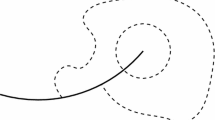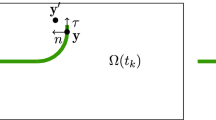Abstract
Topological derivatives provide the variation of a functional when an infinitesimal hole is introduced into the domain. In Silva et al. (J Mech Phys Solids 59(5):925–939, 2011), the authors developed a first-order approximation of the energy release rate associated with a small crack at any boundary location and at any orientation using a first-order topological derivative. This approach offers significant computational advantages over other methods because (i) it requires only a single analysis while other methods require an analysis for each crack size-location-direction combination, and (ii) it is performed on the non-cracked domain, removing the need to create very fine meshes in the vicinity of the crack. In the present study, higher-precision approximations of the energy release rate are developed using higher-order topological derivatives which allow the analyst to accurately treat longer cracks and determine the crack lengths for which the first-order approximation is accurate.

















Similar content being viewed by others
Notes
In the equations that follow, the \(\hat{{\mathbf {x}}}\) and \(\alpha \) dependencies of the domain \(\Omega _\varepsilon \) and boundaries \(\partial \Omega _\varepsilon \) and \(\gamma _\varepsilon \) are dropped for conciseness.
References
Amstutz S, Horchani I, Masmoudi M (2005) Crack detection by the topological gradient method. Control Cybern 34(1):81–101
Auroux D, Masmoudi M (2006) A one-shot inpainting algorithm based on the topological asymptotic analysis. Comput Appl Math 25(2–3):251–267
Beghini M, Bertini L, Fontanari V (1999) Stress intensity factors for an inclined edge crack in a semiplane. Eng Fract Mech 62(6):607–613
Bonnet M (2008) Discussion of ’second order topological sensitivity analysis’ by j. rocha de faria et al. Int J Solids Struct 45(2):705–707
Bonnet M, Constantinescu A (2005) Inverse problems in elasticity. Inverse Probl 21(2):R1–R50
Cea J, Garreau S, Guillaume P, Masmoudi M (2000) The shape and topological optimization connection. Comput Methods Appl Mech Eng 188(4):713–726
de Faria JR, Novotny AA (2009) On the second order topological asymptotic expansion. Struct Multidiscip Optim 39(6):547–555
de Faria JR, Novotny AA, Feijoo RA, Taroco E, Padra C (2007) Second order topological sensitivity analysis. Int J Solids Struct 44(14–15):4958–4977
de Faria JR, Novotny AA, Feijoo RA, Taroco E, Padra C (2008) Response to the ’discussion of second order topological sensitivity analysis’ by m. bonnet. Int J Solids Struct 45(2):708–711
de Faria JR, Novotny AA, Feijoo R, Taroco E (2009) First- and second-order topological sensitivity analysis for inclusions. Inverse Probl Sci Eng 17(5):665–679
Eschenauer HA, Kobelev VV, Schumacher A (1994) Bubble method for topology and shape optimization of structures. Struct Multidiscip Optim 8(1):42–51
Feijoo GR (2004) A new method in inverse scattering based on the topological derivative. Inverse Probl 20(6):1819–1840
Feijoo RA, Padra C, Saliba R, Taroco E, Vénere MJ (2000) Shape sensitivity analysis for energy release rate evaluation and its application to the study of three-dimensional cracked bodies. Comput Methods Appl Mech Eng 188(4):649–664
Garreau S, Guillaume P, Masmoudi M (2001) The topological asymptotic for pde systems: the elasticity case. SIAM J Control Optim 39(6):1756–1778
Goethem NV, Novotny AA (2010) Crack nucleation sensitivity analysis. Math Methods Appl Sci 33(16):1978–1994
Griffith AA (1921) The phenomena of rupture and flow in solids. Philos Trans R Soc Lond Ser A Contain Pap Math Phys Character 221:163–198
Khludnev AM, Novotny AA, Sokolowski J, Zochowski A (2009) Shape and topology sensitivity analysis for cracks in elastic bodies on boundaries of rigid inclusions. J Mech Phys Solids 57(10):1718–1732
Kodsi C (2016) Crack initiation: a non-local energy approach. Eng Fract Mech 165:153–182
Kozlov V, Maz’ya V, Movchan A (1999) Asymptotic analysis of fields in multiStructures. Oxford University Press, Oxford
Larrabide I, Feijoo RA, Novotny AA, Taroco EA (2008) Topological derivative: a tool for image processing. Comput Struct 86(13–14):1386–1403
Leugering G, Sokolowski J, Zochowski A (2015) Control of crack propagation by shape-topological optimization. Discrete Contin Dyn Syst Ser A 35(6):2625–2657
Masmoudi M, Pommier J, Samet B (2005) The topological asymptotic expansion for the maxwell equations and some applications. Inverse Probl 21(2):547–564
Norato JA, Bendsoe MP, Haber RB, Tortorelli DA (2007) A topological derivative method for topology optimization. Struct Multidiscipl Optim 44(4–5):375–386
Novotny AA, Feijoo RA, Taroco E, Padra C (2003) Topological sensitivity analysis. Comput Methods Appl Mech Eng 192(7–8):803–829
Rice JR (1968) A path independent integral and the approximate analysis of strain concentration by notches and cracks. J Appl Mech 35(2):379–386
Silva M, Geubelle PH, Tortorelli DA (2011) Energy release rate approximation for small surface-breaking cracks using the topological derivative. J Mech Phys Solids 59(5):925–939
Sokolowski J, Zochowski A (1999) On the topological derivative in shape optimization. SIAM J Control Optim 37(4):1251–1272
Tada H, Paris PC, Irwin GR (2000) The stress analysis of cracks handbook, 3rd edn. New York,<CHECK>American Society of Mechanical Engineers</CHECK>
Taroco E (2000) Shape sensitivity analysis in linear elastic fracture mechanics. Comput Methods Appl Mech Eng 188(4):692–712
Williams ML (1957) On the stress distribution at the base of a stationary crack. J Appl Mech 24(1):109–114
Acknowledgements
The authors gratefully acknowledge the support of the National Science Foundation (Award CMI-1200086). The authors also appreciate the rewarding comments from the reviewers, the invaluable conversations with Tom Curtin of BEASY USA - Computational Mechanics Inc, and the excellent work of Mariana Silva Sohn at the University of Illinois at Urbana-Champaign. This work was performed under the auspices of the U.S. Department of Energy by Lawrence Livermore National Laboratory under Contract DE-AC52-07NA27344.
Author information
Authors and Affiliations
Corresponding author
A weight functions
A weight functions
In Sect. 3.3, the weight functions for an edge crack in a half-plane were used to relate the stress intensity factors to the load applied to the crack surface \(\gamma _\varepsilon \). These weight functions were calculated numerically using the boundary element method on a \(2w \times 2h\) domain. It was determined that dimensions of \(h,w\ge 100\varepsilon \) were required for the numerical approximation to sufficiently represent a half-plane (Fig. 18).
The prescribed traction \(\tilde{{\mathbf {t}}}\) on the crack face can be expressed as a polynomial in terms of the scaled coordinate \(\xi \),
The stress intensity factors are then given in terms of the prescribed traction as
where \(\tilde{{\mathbf {t}}}_{k} = {\mathbf {T}}^{(k)}{\mathbf {e}}_\theta \).
In this work, the weight functions \(h_{ij}^{(k)}(\alpha )\) are calculated by solving problems with prescribed tractions on the crack face of \(\tilde{{\mathbf {t}}}_k=\xi ^{k}{\mathbf {e}}_\theta \) and \(\tilde{{\mathbf {t}}}_k=\xi ^{k}{\mathbf {e}}_r\). The former is used to calculate \(h_{i1}^{(k)}(\alpha )\) while the latter is used to calculate \(h_{i2}^{(k)}(\alpha )\). For example, when \(\tilde{{\mathbf {t}}}_k=\xi ^{k}{\mathbf {e}}_\theta \) then \(T^{(j)}_{r\theta }=0\) and Eq. (54) becomes
The \(h_{ij}^{(k)}(\alpha )\) were calculated for \(0 \le \alpha \le 70^{\circ }\) in increments of \(1^{\circ }\). The prescribed tractions used to solve for \(h_{ij}^{(0)}(\alpha )\), \(h_{ij}^{(1)}(\alpha )\), and \(h_{ij}^{(2)}(\alpha )\) are shown in Fig. 19.
Rights and permissions
About this article
Cite this article
Alidoost, K., Geubelle, P.H. & Tortorelli, D.A. Energy release rate approximation for edge cracks using higher-order topological derivatives. Int J Fract 210, 187–205 (2018). https://doi.org/10.1007/s10704-018-0271-1
Received:
Accepted:
Published:
Issue Date:
DOI: https://doi.org/10.1007/s10704-018-0271-1






